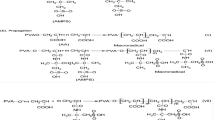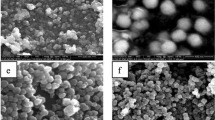Abstract
Biodegradable N-maleyl gelatin (N-MAGEL) was synthesized with gelatin (GEL) and maleic anhydride (MAH) by acylation. With Bis-acrylamide (Bis) cross-linker, a series of cross-linked poly (N-isopropylacrylamide-co-N-maleyl gelatin) [P(NIPAAm-co-N-MAGEL)] hydrogels were prepared, and their lower critical solution temperature (LCST), water content, swelling/deswelling kinetics, drug delivery behaviors, and enzymatic degradation properties were investigated. As weight ratios of N-MAGEL/NIPAAm in hydrogel were increasing, water content increased, and it had no significant influence on LCST of hydrogel in spite of the weight ratios reaching 30:70. In the swelling/deswelling kinetics, hydrogels with higher weight ratios of N-MAGEL/NIPAAm exhibited faster swelling rate and slower deswelling rate. Drug delivery for bovine serum albumin (BSA) research indicated that increasing weight ratios of N-MAGEL/NIPAAm in hydrogels contribute to raising release time and cumulative release ratios. Lastly, hydrogels with higher weight ratios of N-MAGEL/NIPAAm degraded rapidly in phosphate-buffered saline (PBS) containing papain.










Similar content being viewed by others
References
Buwalda SJ, Boere KWM, Dijkstra PJ (2014) Hydrogels in a historical perspective: from simple networks to smart materials. J Control Release 190:254–273
Hoffman AS (2002) Hydrogels for biomedical applications. Adv Drug Deliv Rev 54(1):3–12
Yu Y, Li Y, Liu L (2011) Synthesis and characterization of pH-and thermoresponsive poly (N-isopropylacrylamide-co-itaconic acid) hydrogels crosslinked with N-maleyl chitosan. J Polym Res 18(2):283–291
Yu Y, Li Z, Tian H (2007) Synthesis and characterization of thermoresponsive hydrogels cross-linked with acryloyloxyethylaminopolysuccinimide. Colloid Polym Sci 285(14):1553–1560
Yu Y, Xu Y, Ning H (2008) Swelling behaviors of thermoresponsive hydrogels cross-linked with acryloyloxyethylaminopolysuccinimide. Colloid Polym Sci 286(10):1165–1171
Young S, Wong M, Tabata Y (2005) Gelatin as a delivery vehicle for the controlled release of bioactive molecules. J Control Release 109(1):256–274
Cui L, Jia J, Guo Y (2014) Preparation and characterization of IPN hydrogels composed of chitosan and gelatin cross-linked by genipin. Carbohydr Polym 99:31–38
Loth T, Hötzel R, Kascholke C (2014) Gelatin-based biomaterial engineering with anhydride-containing oligomeric cross-linkers. Biomacromolecules 15(6):2104–2118
Wu ZX, Zou XY, Yang LL (2014) Thermosensitive hydrogel used in dual drug delivery system with paclitaxel- loaded micelles for in situ treatment of lung cancer. Colloids Surf B: Biointerfaces 122:90–98
West JL, Hubbell JA (1999) Polymeric biomaterials with degradation sites for proteases involved in cell migration. Macromolecules 32(1):241–244
Jamilah B, Harvinder KG (2002) Properties of gelatins from skins of fish—black tilapia (Oreochromis mossambicus) and red tilapia (Oreochromis nilotica). Food Chem 77(1):81–84
Duconseille A, Astruc T, Quintana N (2015) Gelatin structure and composition linked to hard capsule dissolution: a review. Food Hydrocoll 43:360–376
Nagai T, Tanoue Y, Kai N (2014) Collagen hydrolysates derived from Yezo sika deer (Cervus nippon yesoensis) tendon have highly health-promoting potentials. Int Food Res J 21(4):1395–1404
Acknowledgments
This research was supported by the National Natural Science Foundation of China (No. 20876081) and the Science Foundation of Shandong Province (ZR2012BM015).
Author information
Authors and Affiliations
Corresponding author
Rights and permissions
About this article
Cite this article
Zheng, Y., Wang, B., Liu, M. et al. Synthesis and characterization of biodegradable thermoresponsive N-maleyl gelatin-co-P(N-isopropylacrylamide) hydrogel cross-linked with Bis-acrylamide for control release. Colloid Polym Sci 293, 1615–1621 (2015). https://doi.org/10.1007/s00396-015-3544-5
Received:
Revised:
Accepted:
Published:
Issue Date:
DOI: https://doi.org/10.1007/s00396-015-3544-5




